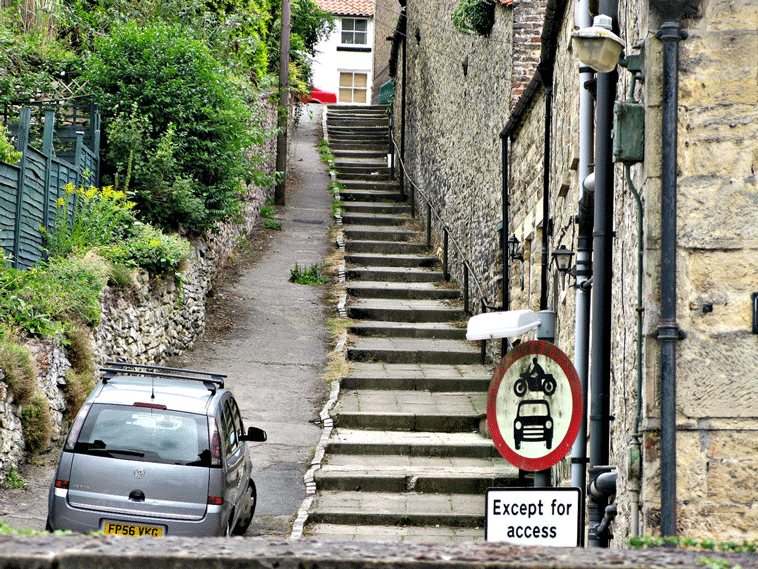John Lotherington reflects on the ongoing debate about the impact of the community-led flood defences in Pickering after the town was spared the flooding that hit large parts of northern England in late-2015.
. . .
As significant parts of northern England went under water during the Christmas period of 2015, one small town that stayed dry, despite having suffered badly in the floods of 2007, was Pickering in North Yorkshire. Lying low below the North York Moors, with increasing risks of inundation owing to changing land use, there had been much discussion after previous floods around a proposal to construct a flood wall within the town. That had been controversial locally, owing to the visual impact it would have had and the effect on tourism, but in any event it was ruled out by government rules on funding as not protecting enough property for the cost (£20 million).
Some local citizens then took the initiative, bringing together their local knowledge and experience of how previous floods had hit, along with expertise in both the natural and social sciences from the universities of Oxford, Newcastle and Durham. They jointly developed the ‘slow the flow’ scheme, involving a series of leaky dams above the town and other small obstructions to even out the run-off of water and reduce the risk of devastating surges.
The largest part of the scheme was a bund inspired by an historical example in the area constructed by the monks of the medieval Byland Abbey. Researchers from Oxford outlined their version of how they joined forces with the local community against flooding. This was reckoned to be a model of engagement, of local knowledge and choices married with technical expertise, only waiting to be tested – the deluge duly came over Christmas 2015 and there was no repetition of the flooding experienced four times between 1999 and 2007. In the Independent of 2nd January 2016, the environmental journalist, Geoffrey Lean celebrated Pickering’s story – ‘UK flooding: How a Yorkshire town worked with nature to stay dry’ – with its lessons for other communities in a similar situation. The story went viral.
But had it really been a deluge? In the Guardian on 7th January 2016, Jeremy Biggs, Director of the Freshwater Habitats Trust, argued that ‘Working with nature’ didn’t save Pickering from the floods – it just didn’t rain much’. Biggs thought that the Pickering scheme had only limited value, and it hadn’t been tested – he asserted that the rainfall in the area, in contrast to other parts of northern England, had not been much above average. Pickering and towns in a similar situation should look to bigger schemes including the adaptation of large floodplains to temporarily store billions of litres of water, a model promoted by the Freshwater Habitats Trust, with additional benefits for nature conservancy.
Lean in turn rebutted Biggs’ statistics ‒ Despite the critics, Pickering’s natural flood defences do seem to have saved the town (it rained plenty!) He cited the well above average rainfall figures recorded at a closer weather station than the one cited by Biggs, and for the specific days in question rather than a monthly total. He also quoted the views of locals who were convinced that the unremitting rain of those Christmas days onto saturated ground would have caused a flood prior to the installation of the ‘slow the flow’ scheme.
But the argument was also local. In a letter to newspapers Councillor Di Keal from nearby Norton acknowledged the success of the ‘slow the flow’ scheme but claimed that it had been hyped up and that there still needed to be hard defences – a flood wall – as well as soft, to defend Pickering fully against the scale of a flood such as the one in 2007. Her advocacy of such a scheme, similar to one installed in Norton, was not successful, for which she blamed ‘a vocal minority of people in the town who led a campaign of misinformation against the project’.
Councillor Mike Potter, chairman of the Pickering and District Civic Society, remains convinced that their ‘slow the flow’ scheme has been an outstanding success.
Pickering’s ‘slow the flow’ scheme will no doubt continue to be tested further by future rain and future arguments. But, whatever happens, a community has been energised and innovative local knowledge has been brought into play in collaboration with academic expertise. And the £20 million scheme to build a flood wall wasn’t going to be funded because of government rules about cost effectiveness. If the citizens of Pickering had sat back passively waiting for the authorities to act, it looks pretty likely they would have had a major clean-up operation with which to end 2015.
Download
The provocation is available for download in pdf.
Pickering, UK (CC BY-NC 2.0) Zoe Rimmer / Flickr




